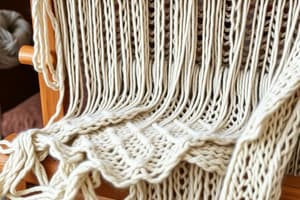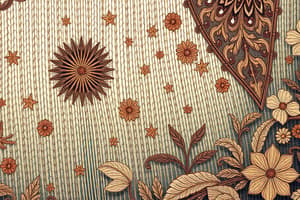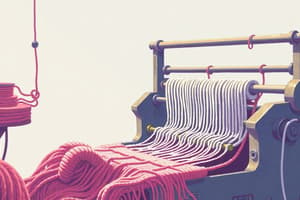Podcast
Questions and Answers
¿Cuál es la principal diferencia entre la producción de trenzas y la estructura de mallas aran?
¿Cuál es la principal diferencia entre la producción de trenzas y la estructura de mallas aran?
- El aran utiliza solo un hilo, mientras que las trenzas usan dos.
- En las trenzas los puntos son generan un diseño más sencillo.
- La técnica de aran no permite variaciones en el diseño.
- Las trenzas tienen brazos con puntos convergentes, mientras que en aran son divergentes. (correct)
¿Cuántas agujas mínimas se requieren para considerar un tejido como Jacquard?
¿Cuántas agujas mínimas se requieren para considerar un tejido como Jacquard?
- 7 agujas
- 10 agujas
- 5 agujas (correct)
- 3 agujas
¿Qué caracteriza al campo de muestra en un tejido Jacquard?
¿Qué caracteriza al campo de muestra en un tejido Jacquard?
- Es el área donde se determina el tipo de hilo a usar.
- Es una zona rectangulada para dibujar patrones complejos. (correct)
- Es el lugar donde las agujas se agrupan para crear el tejido.
- Es un diseño que se repite de manera circular.
¿Cuál es la función principal de los tejidos vanisados?
¿Cuál es la función principal de los tejidos vanisados?
¿Qué se utiliza para dar elasticidad a un tejido en el proceso de vanisado?
¿Qué se utiliza para dar elasticidad a un tejido en el proceso de vanisado?
En el tejido Jacquard, ¿qué forma pueden tener los patrones generados?
En el tejido Jacquard, ¿qué forma pueden tener los patrones generados?
¿Qué tipo de tejido se obtiene con la utilización de dos hilos diferentes en los tejidos vanisados?
¿Qué tipo de tejido se obtiene con la utilización de dos hilos diferentes en los tejidos vanisados?
¿En qué tipo de tejido se utiliza técnica de ligamento jersey?
¿En qué tipo de tejido se utiliza técnica de ligamento jersey?
¿Qué tipo de tejido se obtiene al utilizar agujas fuera de trabajo en la máquina?
¿Qué tipo de tejido se obtiene al utilizar agujas fuera de trabajo en la máquina?
¿Cuál es la principal característica del ligamento ribi?
¿Cuál es la principal característica del ligamento ribi?
¿Cómo se define el ligamento Morley?
¿Cómo se define el ligamento Morley?
¿Cuál de las siguientes afirmaciones describe correctamente el Punto Roma?
¿Cuál de las siguientes afirmaciones describe correctamente el Punto Roma?
¿Qué propiedad tiene el tejido Interlock en comparación con el tejido normal?
¿Qué propiedad tiene el tejido Interlock en comparación con el tejido normal?
¿Qué hace que el Punto Inglés aparente ser más grueso de lo que realmente es?
¿Qué hace que el Punto Inglés aparente ser más grueso de lo que realmente es?
¿Cuál es una característica distintiva del Punto Perlé?
¿Cuál es una característica distintiva del Punto Perlé?
¿Qué ventaja ofrece el ligamento Morley en su estructura respecto al Ribb?
¿Qué ventaja ofrece el ligamento Morley en su estructura respecto al Ribb?
Para qué se utiliza principalmente el tejido Ribb?
Para qué se utiliza principalmente el tejido Ribb?
El traslado de mallas en el tejido permite:
El traslado de mallas en el tejido permite:
Cuál es una diferencia fundamental entre el tejido Ribb y el tejido Morley?
Cuál es una diferencia fundamental entre el tejido Ribb y el tejido Morley?
Los aumentos y disminuciones en el tejido se refieren a:
Los aumentos y disminuciones en el tejido se refieren a:
¿Qué ventaja tiene el uso del traslado de mallas en la producción de prendas?
¿Qué ventaja tiene el uso del traslado de mallas en la producción de prendas?
¿Qué aspecto tiene el tejido Interlock en comparación con el tejido jersey?
¿Qué aspecto tiene el tejido Interlock en comparación con el tejido jersey?
Las máquinas que utilizan hilo de trama pueden realizar el traslado de mallas para:
Las máquinas que utilizan hilo de trama pueden realizar el traslado de mallas para:
La técnica del Punto Roma se utiliza principalmente para crear:
La técnica del Punto Roma se utiliza principalmente para crear:
¿Qué es una prenda integral o completa en el contexto de la producción de indumentaria?
¿Qué es una prenda integral o completa en el contexto de la producción de indumentaria?
¿Cuál es un ejemplo típico de prenda íntegramente tejida según el texto?
¿Cuál es un ejemplo típico de prenda íntegramente tejida según el texto?
¿Qué tipo de prenda utiliza la combinación de tejido tubular y menguado según el contenido?
¿Qué tipo de prenda utiliza la combinación de tejido tubular y menguado según el contenido?
¿Cuál es una ventaja del proceso de producción de prendas integrales?
¿Cuál es una ventaja del proceso de producción de prendas integrales?
¿Cuál es una desventaja de la producción de prendas integrales?
¿Cuál es una desventaja de la producción de prendas integrales?
¿Cómo se forman los talones y punteras en las medias según el contenido?
¿Cómo se forman los talones y punteras en las medias según el contenido?
¿Qué característica tienen las prendas integrales que pueden ser reversibles?
¿Qué característica tienen las prendas integrales que pueden ser reversibles?
¿Qué requerimiento es necesario para amortizar los altos costos de tecnología en la producción de prendas integrales?
¿Qué requerimiento es necesario para amortizar los altos costos de tecnología en la producción de prendas integrales?
¿Qué caracteriza al vanisado invertido en máquinas?
¿Qué caracteriza al vanisado invertido en máquinas?
¿Cómo se producen los tejidos 'intarsia'?
¿Cómo se producen los tejidos 'intarsia'?
¿Cuál es el objetivo de sellar los bordes inferiores de los paños?
¿Cuál es el objetivo de sellar los bordes inferiores de los paños?
¿Qué tipo de máquinas se utilizan para crear tejidos 'intarsia'?
¿Qué tipo de máquinas se utilizan para crear tejidos 'intarsia'?
¿Qué son los paños en la producción de prendas?
¿Qué son los paños en la producción de prendas?
¿Qué se puede iniciar en un paño además de los bordes sellados?
¿Qué se puede iniciar en un paño además de los bordes sellados?
¿Cuál de las siguientes afirmaciones sobre el vanisado es incorrecta?
¿Cuál de las siguientes afirmaciones sobre el vanisado es incorrecta?
¿Qué técnica permite una variación de tamaño en la zona tejida durante el proceso de intarsia?
¿Qué técnica permite una variación de tamaño en la zona tejida durante el proceso de intarsia?
¿Cuál es la principal ventaja de tejer los paños mencionados en el contenido?
¿Cuál es la principal ventaja de tejer los paños mencionados en el contenido?
¿Qué se hace frecuentemente antes de realizar el corte de los paños?
¿Qué se hace frecuentemente antes de realizar el corte de los paños?
¿Cuál es una desventaja de la técnica de tejido mencionada?
¿Cuál es una desventaja de la técnica de tejido mencionada?
¿Qué factor influye en la velocidad de realización del paño?
¿Qué factor influye en la velocidad de realización del paño?
¿Cómo se obtienen las formas de las sisas, caída de hombros y escote en el tejido?
¿Cómo se obtienen las formas de las sisas, caída de hombros y escote en el tejido?
¿Qué se puede hacer para evitar distorsiones en el talle y en las formas durante el tejido?
¿Qué se puede hacer para evitar distorsiones en el talle y en las formas durante el tejido?
¿Qué característica tienen los paños en cuanto a su longitud?
¿Qué característica tienen los paños en cuanto a su longitud?
¿Cuál es la velocidad máxima de producción con las máquinas más avanzadas?
¿Cuál es la velocidad máxima de producción con las máquinas más avanzadas?
Flashcards
Aran
Aran
A knitted fabric structure, similar to braids, but with diverging columns of stitches instead of converging ones.
Jacquard
Jacquard
A knit fabric created with a machine that individually selects needles. It produces patterns.
Jacquard field
Jacquard field
A rectangular area used to create patterns in Jacquard knits.
Vanisado
Vanisado
Signup and view all the flashcards
Jacquard jersey
Jacquard jersey
Signup and view all the flashcards
Jacquard eye of partridge
Jacquard eye of partridge
Signup and view all the flashcards
Jacquard tubular
Jacquard tubular
Signup and view all the flashcards
Jacquard rib
Jacquard rib
Signup and view all the flashcards
Desagujado
Desagujado
Signup and view all the flashcards
1-1 Desagujado
1-1 Desagujado
Signup and view all the flashcards
Falso Acanalado
Falso Acanalado
Signup and view all the flashcards
Ribb
Ribb
Signup and view all the flashcards
Morley
Morley
Signup and view all the flashcards
Punto Interlock
Punto Interlock
Signup and view all the flashcards
Tejidos de dos caras
Tejidos de dos caras
Signup and view all the flashcards
Ligamento
Ligamento
Signup and view all the flashcards
Punto Roma
Punto Roma
Signup and view all the flashcards
Punto Milano
Punto Milano
Signup and view all the flashcards
Punto Inglés
Punto Inglés
Signup and view all the flashcards
Punto Perlé
Punto Perlé
Signup and view all the flashcards
Traslado de Mallas
Traslado de Mallas
Signup and view all the flashcards
Aumentos y Disminuciones
Aumentos y Disminuciones
Signup and view all the flashcards
Machine Knitting Techniques
Machine Knitting Techniques
Signup and view all the flashcards
Knitting Fronts and Backs
Knitting Fronts and Backs
Signup and view all the flashcards
Reversed Vanisado
Reversed Vanisado
Signup and view all the flashcards
Intarsia
Intarsia
Signup and view all the flashcards
Intarsia Machine
Intarsia Machine
Signup and view all the flashcards
Pieces/Panels
Pieces/Panels
Signup and view all the flashcards
Panel edges
Panel edges
Signup and view all the flashcards
Garment Production Method
Garment Production Method
Signup and view all the flashcards
Sewing with Pre-made Fabric Panels
Sewing with Pre-made Fabric Panels
Signup and view all the flashcards
Panel Starting Structure
Panel Starting Structure
Signup and view all the flashcards
Fabric width limitations
Fabric width limitations
Signup and view all the flashcards
Multiple panels
Multiple panels
Signup and view all the flashcards
Pre-cutting preparation
Pre-cutting preparation
Signup and view all the flashcards
Panel weaving alignment
Panel weaving alignment
Signup and view all the flashcards
Panel-to-pattern matching
Panel-to-pattern matching
Signup and view all the flashcards
Sewing seams
Sewing seams
Signup and view all the flashcards
Advantages of panel weaving
Advantages of panel weaving
Signup and view all the flashcards
Disadvantages of panel weaving
Disadvantages of panel weaving
Signup and view all the flashcards
Fully Fashioned Production Sequence
Fully Fashioned Production Sequence
Signup and view all the flashcards
Whole Garment (Wholegarment)
Whole Garment (Wholegarment)
Signup and view all the flashcards
Advantages of Wholegarment
Advantages of Wholegarment
Signup and view all the flashcards
Disadvantages of Wholegarment
Disadvantages of Wholegarment
Signup and view all the flashcards
Wholegarment example (hats)
Wholegarment example (hats)
Signup and view all the flashcards
Wholegarment example (knitted socks)
Wholegarment example (knitted socks)
Signup and view all the flashcards
Wholegarment example (gloves)
Wholegarment example (gloves)
Signup and view all the flashcards
Wholegarment production efficiency
Wholegarment production efficiency
Signup and view all the flashcards
Study Notes
Técnicas de Producción de Indumentaria 2 - Sweaters - Tejido de Punto
- Hilados: Fibras naturales (animales y vegetales)
- Lana: Obtenida del vellón de oveja, es la más usada en tejido de punto por su elasticidad. Diferencias de calidad por raza (ej: Merino).
- Pelo: De animales distintos a las ovejas. (Ej: Mohair, Angora, Cachemira). Suelen mezclarse con lana.
- Seda: Única fibra natural en filamento. Fuerte, suave y brillante. A menudo se mezcla con otras fibras.
- Lino: Fibras largas del tallo de la planta de lino. Poco elástico, se mezcla con otras fibras. Textura irregular.
- Algodón: Fibras de la planta de algodón. Fuerte, suave, y sin elasticidad. El algodón no tratado es más difícil de trabajar que el mercerizado.
- Hilados artificiales:
- Regeneradas: De sustancias naturales (ej: pulpa de madera, celulosa, leche). El rayón es el más conocido y sustituto de seda. Viscosa y acetato, son derivados de rayón.
- Sintéticas: De compuestos químicos (ej: petróleo, plástico, carbón). Ejemplos: acrílico, poliamida, poliéster. Los hilos de fibra rizada de acrílico son similares a la lana, pero menos duraderos y cálidos.
Tejidos de Punto
- Definición: Tela móvil y elástica, adaptada al cuerpo. Hilo entrelazado.
- Por trama: El hilo corre horizontal. Mayor posibilidad de diseños. Puede tejer prendas completas o en piezas. Se puede destejer.
- Por urdimbre: El hilo corre vertical. Mallas adyacentes.
- Generalmente se elabora en piezas y no se puede destejer.
Componentes Básicos de la Máquina de Tejido de Punto
- Agujas
- Levas de formación
- Fronturas
- Galga
Levas de formación
- Elemento mecánico que guía el movimiento de las agujas para el tejido.
- Guían el ascenso y descenso de las agujas en el momento preciso.
Fronturas
- Placa metálica con ranuras donde se alojan las agujas.
- Las máquinas de tricotajes pueden tener 1 ó 2 fronturas.
Galga
- Número de agujas por pulgada en la frontura.
- Sirve para medir la densidad de tejido.
Otros tipos de tejidos
- Punto Retenida: Agujas que no trabajan.
- Tejido de una cara: Punto Jersey (muy común), se basa en un punto liso.
- Tejidos de dos caras: Ribb, Morley, punto Interlock, Punto Roma, Punto Milano, Punto Inglés y punto Perlé.
- Tejidos Vanisados: Crean diferentes colores en el mismo tejido, mezclando múltiples hilos gradualmente en diferentes aspectos del tejido.
- Tejido Jacquard: Permite diseños complejos con diferentes colores. El diseño se realiza en áreas separadas del tejido.
- Tejido Intarsia: Se realiza con diferentes colores en zonas específicas, sin interrumpir la trama.
Studying That Suits You
Use AI to generate personalized quizzes and flashcards to suit your learning preferences.




